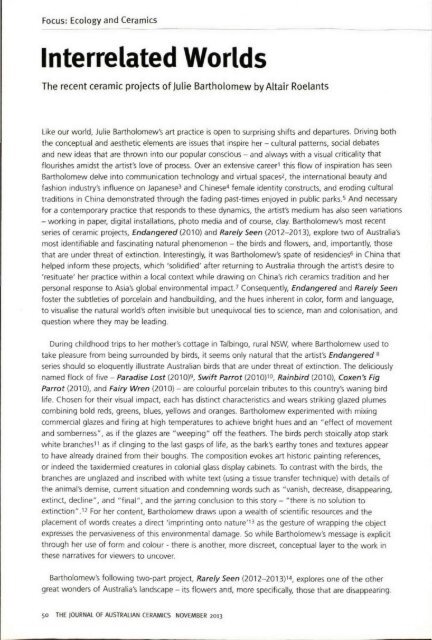The Journal of Australian Ceramics Vol 52 No 3 November 2013
You also want an ePaper? Increase the reach of your titles
YUMPU automatically turns print PDFs into web optimized ePapers that Google loves.
Focus: Ecology and <strong>Ceramics</strong><br />
Interrelated Worlds<br />
<strong>The</strong> recent ceramic projects <strong>of</strong> Julie Bartholomew by Altair Roelants<br />
Like our world, Julie Bartholomew's art practice is open to surprising shifts and departures. Driving both<br />
the conceptual and aesthetic elements are issues that inspire her - cu ltural pattern s, social debates<br />
and new ideas that are th rown into our popular conscious - and always with a visual criticality that<br />
flourishes amidst the artist's love <strong>of</strong> process. Over an extensive career' this flow <strong>of</strong> inspiration has seen<br />
Bartholomew delve into communication technology and virtual spaces2, the international beauty and<br />
fashion industry's influence on Japanese 3 and Chinese 4 female identity constructs, and eroding cultural<br />
traditions in China demonstrated through the fading past-times enjoyed in public parks.S And necessary<br />
for a contemporary practice that responds to these dynamics, the artist's medium has also seen variations<br />
- working in paper, digital installations, photo media and <strong>of</strong> course, clay. Bartholomew'S most recent<br />
series <strong>of</strong> ceramic projects, Endangered (2010) and Rarely Seen (2012-<strong>2013</strong>), explore two <strong>of</strong> Australia's<br />
most identifiable and fascinating natural phenomenon - the birds and flowers, and, importantly, those<br />
that are under threat <strong>of</strong> extinction. Interestingly, it was Bartholomew's spate <strong>of</strong> residencies 6 in China that<br />
helped inform these projects, which 'solidified' after returning to Australia through the artist's desire to<br />
'resituate' her practice within a local context while drawing on China's rich ceramics tradition and her<br />
personal response to Asia's global environmental impact.1 Consequently, Endangered and Rarely Seen<br />
foster the subtleties <strong>of</strong> porcelain and handbuilding, and the hues inherent in color, form and language,<br />
to visualise the natural world's <strong>of</strong>ten invisible but unequivocal ties to science, man and colonisation, and<br />
question where they may be leading.<br />
During childhood trips to her mother'S cottage in Talbingo, rural N5W, where Bartholomew used to<br />
take pleasure from being surrounded by birds, it seems only natural that the artist's Endangered 8<br />
series should so eloquently illustrate <strong>Australian</strong> birds that are under threat <strong>of</strong> extinction. <strong>The</strong> deliciously<br />
named flock <strong>of</strong> five - Paradise Lost (2010)9, Swift Parrot (2010),0, Rainbird (2010), Coxen's Fig<br />
Parrot (2010), and Fairy Wren (2010) - are colourful porcelain tributes to this country's waning bird<br />
life. Chosen for their visual impact, each has distinct characteristics and wears striking glazed plumes<br />
combining bold reds, greens, blues, yellows and oranges. Bartholomew experimented with mixing<br />
commercial glazes and firing at high temperatures to achieve bright hues and an "effect <strong>of</strong> movement<br />
and somberness", as if the glazes are "weeping" <strong>of</strong>f the feathers. <strong>The</strong> bi rds perch stoically atop stark<br />
white branches" as if clinging to the last gasps <strong>of</strong> life, as the bark's earthy tones and textures appear<br />
to have already drained from their boughs. <strong>The</strong> composition evokes art historic painting references,<br />
or indeed the taxidermied creatures in colonial glass display cabinets. To contrast with the birds, the<br />
branches are unglazed and inscribed with white text (using a tissue transfer technique) with details <strong>of</strong><br />
the animal's demise, current situation and condemning words such as "vanish, decrease, disappearing,<br />
extinct, decline", and "final", and the jarring conclusion to this story - "there is no solution to<br />
extinction" .' 2 For her content, Bartholomew draws upon a wealth <strong>of</strong> scientific resources and the<br />
placement <strong>of</strong> words creates a direct 'imprinting onto nature'13 as the gesture <strong>of</strong> wrapping the object<br />
expresses the pervasiveness <strong>of</strong> this environmental damage. 50 while Bartholomew'S message is explicit<br />
through her use <strong>of</strong> form and colour - there is another, more discreet, conceptual layer to the work in<br />
these narratives for viewers to uncover.<br />
Bartholomew'S following two-part project, Rarely Seen (2012-<strong>2013</strong>)14, explores one <strong>of</strong> the other<br />
great wonders <strong>of</strong> Australia's landscape - its flowers and, more specifically, those that are disappearing.<br />
so THE JOURNAL OF AUSTRAllAN CERAM'CS NOVEMBER <strong>2013</strong>

















